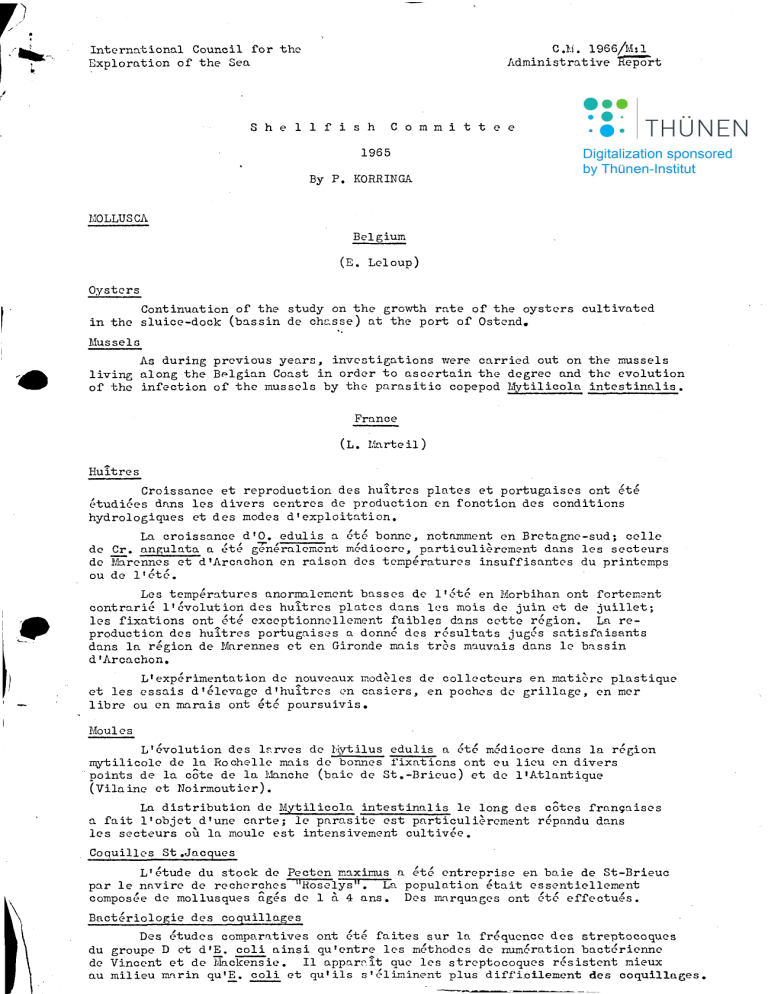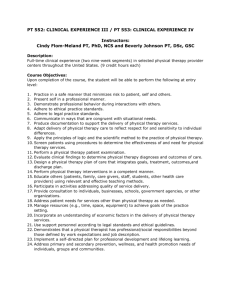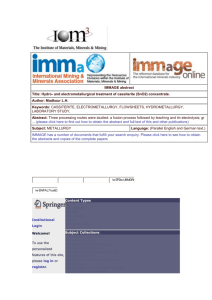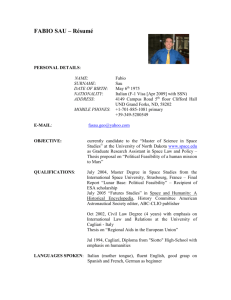r J, ...:...

r
, r
J,
..
...:...
Io'~.
,
~
__"
International Council for thc
Explorntion of the Sen
C.1L 1966/M:l
Administrative Report
S h e l 1 f i s h C
0 m m i t t e e
1965
By P.
KORRINGA
NOLLUSCA
Belgium
(E. Lcloup)
Oystcrs
Continuntion of thc study on the growth rute of thc oysters cultivnted in thc sluice-dock (bassin de ch~sse) nt the port of Ostend.
MusselG
AG du ring previous yenrs, invcGtigntions were carricd out on the musseIs living nlong thc Bplgian Coast in order to nscertnin thc degree nnd thc evolution of thc infcction of thc musseIs by thc parasitic copepod Mytilicoln intestinnlis.
France
(L. l.m.rteil)
Huitrcs
Croissance et reproduction des hultres plutes et portugnises ont 6te etudiees dnns les divers CClltres de production en fonction des conditions hydrologiques et des modes d'exploitation.
La croissance d'O. edulis a ete bonne, notrumment en Bretagne-sud; celle de er.
nn~ulata n 6te g~nernlement m6diocre, pnrticulierement dans les secteurs de Mnrennes et d'Arcnchon en raison des temperatures insuffisantes du printemps ou de 1,et6.
Les temperatures anormulement basses de l'et6 en Morbihnn ont fortement contrnrie l'cvolution des hultres plates dans leB mois dc juin et de juillet; les fixations ont 6te exceptionnellement faibles dans cette region.
Ln reproduction des hultres portuguises a donne des resultats jUG6s sutisfuisants dans In region de lfurennes et en Gironde mais tros mnuvais dans le bassin d'Arcachon.
L'experimentntion de nouvenux modeles de collecteurs en mutiere plustique et les essais d'6levage d'hultrcs on casiers, en poches dc grillage, en mer libre ou en murais ont et6 poursuivis.
Moules
L' evolution des lr.rves de Nytilus edulis a 6te mediocre dans In region mytilicole de la Rochelle mais de bOnlles fixutions ont cu Iieu en divers points de la cate de In Manche (baie de St.-Brieuc) et de l'AtInntique
(Vilaine et Noirmouti0r).
Ln distribution de Mytilicoln intestinnlis le long des eates frnn~aises a fait l'objet d'une cnrtcj 1e parasite est pnrticulierement repnndu dans les secteurs ou la moule est intensivement cultivee.
Coquillcs st.Jaeques
L'etude du stock de Pecten maximus a et6 entreprise en baie de St-Brieuc par le nnvire de recherches IIRosclysli.
Ln population etait essentiellement eompos0e de mollusques ages de 1 a
4 ans.
Des m~rqu~ges ont ete effeetuGs.
Bacteriologie des coquillnges
Des 6tudes compnrQtives ont 6t6 fnites sur In frequence des streptocoques du groupe D et dIE. eoli ninsi qu'entre les methodes de numeration bact6rienne de Vincent et de MQcke:üSie.
11 nppar~lt que les streptocoques resistent mieux au milieu m~rin qu'~.
eoli et qu'ils s'eliminent plus difEicilement des coquillages.
----------
/
\ oe
- 2 -
La methode de Vincent, detectant en outre certains paracoli-bacilles. donne des resultats legerement superieurs u ceux de la methode de 1fuckensie plus specifique d'~ col~.
Germany
(P.F.
~eyer-Waarden) lJIytilus edulis
Routine investigations on the growth and quality of wild and cultivated mussels and observations on the infection rate with Mytilicola intestinalis have been continued at the Institut für Küsten- und Binnenfischerei.
26 sampIes v;ere analysed.
Ireland
(F .A.
Gibson)
Oyst~~
A field station ~~s established at Fenit, Co. Kerry.
This was and will continuc to be the focal point for a comprehcnsive study of the oyster stocks in Tralee Bay.
Spat collectors were positioned in various parts of the oyster grounds und u quite heavy spatfull was recorded.
Areas of excellent spatting success but high mortality as 1 und 2 year old oysters were located.
Many of these will be transplanted in areas where survival to marketable size is more as sured.
ll'..lssels
Further transplantations of musseIs were undertaken on the south-
'west coast, us mg a mechanised dredger for the purpose.
Problems associated with the spa,Vlling and settlement cf mussels on the east coast were studied.
Netherlands
(P.
Korringa)
Q;y:sters
ThC' limited nunber of French oysters relaid in the Oosterschelde.
in combination with poor weather conditions and low water temperatures. led to a complC'te failure of setting in the year 1965.
Relaid Eortuguese oysters could not spawn due to low ,~ter temperatures and henee developed a rather poor flavour.
In December un unusually s~rong run-off of the river Rhine led to exceptionally low salinities (about 20 ~J) in thC' Oosterschelde und hence to weak und dying oysters in the storage ponds at Yerseke.
Norwa:[
(K.R. G:,'ndersen)
Mussels
}/iytilus edulis was very connnon in the middle part of the Sognefjord.
espccially on steep rock beaehes. living fro~ a little below high tide level to
2-3 met res dovmwards in a vertieal direction.
Most of the musseIs were under commercial size, and thc majority of tho~e living at or above mean sea level is destroyed every winter.
In the inne~nost part of the fjord, a top layer of very brackish ~uter forces the spat to settle weIl below low tide level.
- 3 -
'"
In the Oslofjord. the meat content of musseIs has been analysed on a monthly basis. and weekly sampIes have been taken there during the period
April-November to ascertain the mytilotoxin content (PSP).
The PSP ,vas found during 1fuy-June. but only in relatively low concentrations.
At the Institute in Bergen. experiments were started on the cleansing of mussels contaPinated with fuel oil (diesel. solar) in the harbour area.
At the beginning of the experiments. the meat. both raw and boiled. had a very strong smell und taste of oil.
After threc weeks in running seu~wnter at salinities of 30-35 ~, and temperatures from 5 to 20°C, the tastedecreased considerably in intensity. but later on remained constant for more than three months.
The experiments are continued.
Modiola modiolus
In November-December some 12 tons of this bivalve were fishcd near
Bergen for a processing and canning experiment.
Because of the severe winter considerable difficulties were encountered during fishing, since Modiola is very sensitive to frost.
Until delivery to the plant. the mussels were kept in wooden boxes in sheltered bays, well below low tide level, for periods up to two months.
Experiments with are under preparation.
cultivation of mussels on ropes suspended from rafts
Blocks of porous plastics will be used as floats.
Mya arenaria
During May-August the western and southern coasts of Non'my were surveyed for stocks of cornmercial bivalves of economical importance.
Moderate stocks of Mya arenaria. 50-100 or more specimens per square metr~.
were found in some bays in the Sognefjord, on the west coast, the size of the largest beds. exposed at low tide being from 3000 to 1-2 millions square metr~s.
Exploitation wH)., however, be difficult. because the clams live in a very visccus clay of glacial origin.
Portugal
(H. Vilela)
Oysters
Routine observations on spatfall of Oysters (Crassostrea angulato.) in the Sads and Tagus estuary were continued in 1965.
Experiments with collectors for oyster spat were carried out.
The sanitary control of oysters was continued.
Nussels
The studies on the infestation of mussels and other bivo.lves with
Mytilicola intestinalis and Tremo.tcdee were continued.
Spain
(J. Cuesta)
Huitres
La ponte et les larves dl Ostrea edulis, Ostrea plicata et Crassostrea angulato. ont ete etudies dans le N.O. d'Espagne.
Dans 10. region du Santander des essais de repeuplcment ostrcicole ont etc effectues.
Palourdes
Des etudes sur la croissance relative de Tapes decussatus ont 6t6
.continucen.
Coquilles st. Jaques
Des etudes biometriques et biologiques. et particulicrement des etudes concernent la mnturation sexuelle de Pecten maximus. ont et6 exccuteesdans les eo.ux cotieres dans le N.W. d'Espagne.
"
,
-
- 4 -
United Kingdom
I. Englnnd nnd Wales
(H.A. Cole)
Oysters
At the shellfish rearing unit the main effort was concentrated on produoing spat of Ostrea edulis for exp~rimental purposes, principally to test the food value of a wide variety of algal speeies.
The concentrctions of these neeessary for optin:um growth have beenstudied.
Hixed a1gae seem to give better grov~h than single speeies and experiments vdth controlled mixtures are yielding promising results.
°
The standard technique hus been to culture about 100,000 larvae in 75 litre polythene bins but larvae have been cultured successful1y at much higher
°densities by a new technique where 4-500,000 larvae are maintained in glasstubes 10 cm in diameter and 80 cm long, holding on1y 12 litres of water.
Experiments with O. lutaria confirm the impression gained in 1964 thnt the spat growmore slowlY-than those of O. edulis.
Spat of Crassostraa gigas have ueen reared successfully und have gro'vn weIl.
Their resistance to winter conditions is now being tested.
On the east coast of England natural spatfall vas again n failure but in th<.> south west it wa17 moderate.
By retaining SDall Norvregian oyst~rs in storage pits most of thero w<.>re grovm to a size suitable for relaying in open water after one season.
Turbidity estinntions in east const rivers hnve shovm that silt loads do not customarily reach levels likely to interfere with larval development though there are times when the normnl functioning of adult oysters will be impeded.
The quality und condition of Crussostrea anguluta gro~n at various tidal levels is virtually the same up to bO Yo exposure but yield, in terms of grov~h and reduced losses, is greatest at or just below L.W.E.S.T.
Further studies of air-stored oysters huve sho.vn
m~rked increases in the numbers of faeeal streptococci which cannot therefore be regarded as suitable indicators of pollution.
Oysters examined for viruses showed very low levels even in areas where these were plentiful in the se~nge discharged.
Because of the low rate of infection purification tests to determine rates of removul could not be conducted.
MusseIs
1.fytilus edulis
Comparisons of growth rates in different areas havc been made but the main work has been concerned with the problems of relaying sub-littoralbrood on intcrtidal beds.
These musseIs are much lighter than the littoral ones and tend to v~sh away as weIl as bcing more ~asily preyed upon by Carcinus mnenas.
There appears to be a correlation betvreen the minimum sizc of mussel resistant to crab attnck and the original tidnl exposure level of the musseIs.
Experiments vdth vnrious types of seed collector have becn continued and a study made of settlement on the Con~ny beds.
The main sputfall took place in July with small sets in June nnd August.
On the beds survival ~~s poor and very few seed re~~ined after three months.
Cleansing techniques continue to oe studied and it has been sho~n that because the rute of uptake of chlorine is so rapid, t1hypoll need not be nddcd to thc olennsing tnnks.
Other tcchniques for reducing handling during thc cleansing procedure are bcing studied.
°
Comparisons have been ronde of various methods for cstimating sanitary quality and a sensitive M.P.N. technique for estiITnting low level pollution in purified mussels shows promising results.
Shellfish stored in v~ter containing diesel oil bccarnc tnintcd.
The degree of tainting appeared to be a function of conccntrntion and exposurc time.
Over tvro months retention inolean runninß SI?4wuter
~~s necessary to eliminnte the taint.
- 5 -
Experiments with 1~ilicola ~ve shovm that the ndults, including eggcnrrying fe~nles, will lenve host mussels nnd thnt smnll individuals cnn reinfeet the host.
Chlorine nt low concentrntions will destroy the Inrvne but the ndults, und particulnrly the eggs; nre very resistnnt.
Initial concentrntions of 100 p.p.m. und 24 hours exposure nre necessary to give a
100
% kill of the latter nt 20°C~
Cockles.
Cardium edule
Routine surveys of the Burry Inlet hnve been continued to provide infor.mntion on stocks to be used in conjunction vnth the oystercntcher-control progrnmme nnd for regulnting the fishery.
The 1965 settlement, though not as good as in 1963, was still better thnn for mnny other yenrs.
Oystercntcher predation vms less serious thnn usunl because the cockle stock was so much biggl2r.
Experimental thinning of the cockles in vnrious W3ys has ShOVM. thnt where population density is high spatfall is lower, losses greater, grov~h is poorer and ment yield is reduced.
In Morecambe Boy, spntfalls have been poor and there is no indication of n recovery to commercially exploitnble densitles.
Oystt'rcntchers present in the bay still take cockles but feed principally on lfuco~~ nnd Mytilus.
In the Burry Inlet experiments on the use of cannon nets und other methods for controlling the birds have been temporarily hnlted becnuse of the difficulty of obtnining nccess to the roosting nre~s.
Clams, Venus (Mercenaria) mercenaria
Renring techniques similar to those used for oysters have been upplied successfully.
In particular high density culture in vertical glnss-tubes has yielded good results.
Splt-feeding experiments with
0.
variety of algne have been conducted und gro,7th rates studied.
It appenrs tho.t spo.t would huve to be retained in protected conditions for at least two years before being big enough to withstand predation by Co.rcinus.
Studies in Southampton Water have continued.
Though there is still n large natural population there hus been no renlly successful spatfnll since
1 9 6 1 . '
Heavily polluted clams will only clennse satisfactorily in n 48-hour period if kept nt n water temperature above 13°0.
Experiments on methods of handling during cleansing and of storage have mnde it possible to draw up specificutions for n commercial clennsing pInnt.
Escallops, Pccten maximus
Surveys of stocks und their distr ibution huve been made off the Farne
Islunds und part of the Devon const.
In addition a general study of escallop fishing in England and Wales has been made nnd snmples collected for routine studies particularly seasonnl chnnges in the gonnds.
H.
Scotlnnd
(R.H. MilIar and H.J. Thomas)
Oysters
Ostrea edulis L.
Luborutory experiments hnve continued on problems of the physiology of oyster larvne, nrising fro~ studies on the improvemcnt of nrtificial breeding techniques~
Field experiments have started on methods of oyster culture with rnfts, with luboratory-bred spat, in the first place, but later aimcd nt growing oysters to mürket-size by suspended culture.
- 6 -
Scallops
Penten maximus L.
Laboratory and field expe~iments have been started, , to investigate methods of cultivation of the scallop.
Artificial breeding has succeeded and spat were obtained, but larval mortality is still high.
Transplantations of adults have been made and experiments are in progress to investigate the effects of growing at varying densities and on different soils.
Data on catch per unit effort of escallops have been maintained in the Firth of Olyde~ Preliminary examination of these and research-ship data suggest no decline in the catch per unit effort in the stocks of the west side, where three-ringed escallops sometimes predominate in catches.
A slight decline might have occurred in the east, however, where the stocks were generally older and 5- und 6-ringed escallops were more abundant in the catches.
Sampling of escallops has also been undertaken on other grounds off the west coast.
Cockles
Cardium edu1e
Further surveys ha ve been made cockle area lies high up on the shore.
carried out.
After two months, of the neaps 50 % has survived and grovm more upper shore.
Cephalopodn.
of the cockle beds at Barra.
A transplantation experiment cockles transpInnted to about rupidly than those remaining
The main has been low water on the
Rccords have been maintained of the comnercia1 In.ndings of squid.
Thc data suggest that the autumn influx into coastal wnters in 1965 ~~s somewhat greater thn.n the very low level of the previous two years.
The commercial catch comprised Lo1igo forbesii of mean size about 14 cm overall length.
In above 10 cm the sexes were about equa1ly represented but the catches were composed almost entire1y of immature specimens.
CRUSTACEA
Be1~ium
(E. Leloup)
Orangon crangon
The biological study of shrimps ~ns continued.
Its aim is to ascertain the annual evolution of the stock of shrimps on the Belgian coast.
Denmark and Greenland
(Aa.J.C. Jensen & E. Smidt)
Homarus vulgaris
In the spring of 1965 investigations were carried out on an unusua1 mortality among lobsters in the Limfjord, North Sea and Skagerrak.
Nephrops norvegicus
Investigations on length and sex of Nephrops were carried out in the northern and centra1 North Sea, Skagerrak and Kn.ttegat.
At the same time tagging was carried out in the Skagerrn.k.
Pandalus borealis
Length n.nd maturity of Pandalus were investigated in the North Sen. und the Skagerrak s imultaneously with the work on Nephrops.,
In Green1nnd waters the annual trawling experiments on prnvm grounds in the Godth~b district have been continued in 1965.
They are to be continued in 1966, and, besides, some trawling experiments vlith RjvlDana"are planned for the Davis Strnit.
- 7 -
Ch~onoecctes opilio (Greenland crab)
In 1965 same trawling experiments with a special crab trawl have been carried out on pra~n grounds in the Godthab district.
Continuation of this work" includirg fishing experiments with the crab trawl in the Disko Bay"is
,planned for the year 1966.
Finland
(S.G. Segerstrü1e)
Cran..-:;on crangon
Studies on the biology of Crangon crangon were made by'A. Petäjä of
Turku University.
France
(L. Marteil)
~~L'lrur; vU!.faris et Palinuris vulgaris
De nombreux marquages de ces crustaces ont ete faits sur In cote bretonne.
!c~hrops norve~icus (Langoustines)
Deux campagnes du "Roselys" ont ete faites" en avril ct en septembre, pour ~tudier le stock de langoustine du Golfe de ~ascogne entre Penmarc'h et l'Ile de Groix ainsi qulautour de 1 1 Ile d'Yeu et du plateau de Rochebonne.
:Ces lots prov~nant de 10.
Her du Nord (Farn Deep et Skagerrak) ont egalement
6-:::6 examin6s.
CJ.Tlccr par,urus d~
U:::e etude du stock de ce crabe est en cours dans le nord et 1e centre
Golfe de Gascogne.
Germany
(P.F. Ueyer-Waurden)
Crf'~ßon crang;on
Tr.e
investigations of the Institut für Küsten- und Binnenfischerei to assess the share of undersized protected fish in the catch of the German shrimp fishe~y, und the fluctuutions in the ubundance of fish species found on the shrimp fishing grounds, huve been continued.
In the year under report 429 sampIes (= 1,895 kg) of unsorted catch of the shrimp fishery were collected in
BÜSUffi, Cuxhnven, Neuhurlingersicl und Dornumersiel and analysed as to their species and ler-gth composition.
The shrimp tugging experiments were continued at the Institut fÜr
[i.isten- und Binnenfischerei.
8,250 shrimps v!ere tagged with coloured plastic tags by the silver ring method from Cuxhaven and Büsum in summer und uutumn.
The investigutions on the distribution of shrimp larvae in relation
-:::0 hydro(;:::,apllic fo.ctors o.long the German coast have been continued at the
Institut für Küsten- und BinnenfischerGi.
During March, April, Hay, June" July,
August, Septe~~er und October 8 cruises uboard the Fisheries Inspection und
~~easC'urch vessel "Neptun" were madC'; 218 stations were visited.
Reuring experiments were carried out ut the Institut fÜr Hydrobiologie und Fischereiwissenschaft of the UnivC'rsity of Hamburg.
Fanch.l
'J.S
S
P •
Durine April to October experinental fishing was carriC'd out during
883 hours on thc Fladen Grouni, Fo.rn Deeps and in the Skugerrak urea" in order to su~vcy the ctock on dcep-G~a pra~ns.
Thc catch composition ~~s roughly det0rrained ubourd and sub-st:1uples of thc crusto.cC'an cutch were tuken to the" lubo:::,utory for deto.iled analysic.
Aseries of storage und processing experiments y~s cnrried out with both ra~ and boilcd pravms.
- 8 -
Icela.nd
(U.
Skula.d6ttir)
Pa.ndalus borea.lis
Routine sampling of pra\vns has been continued.
In addition~ the number of prawns per kg has been established since the autumn season for every boat-load brought in at one of the plants. '
3250 pravms were tagged with black plastic tags.
None has been recaptured the same,year.
l~phrops norvegicus
Routine sampling on Norvmy lobsters has been continued.
Reproduction in
Nephrops has. been studied from May till November 20th by observing the ovaries macroscopically and by measuring the diameter of the eggs attached to the abdomen.
In May 2025 Non~y lobsters were tagged~ partly with the blue American arrow tag, partly with blue and red plastic tags attached to the soft section at the junction of cephalothorax and abdomen.
These tags should stay on after moulting.
In September 445 blue arroW tugs~ 2200 blue plastic tags~ and 500 green Dymotags were attached to Norway lobsters.
None has been recaptured the same year.
Ireland
(F .A. Gibson)
Homarus vulgaris
A total of 867 suture-tagged lobsters were released at Dalkey, Co. Dublin during the per iod February to August.' All recaptures~ whether moulted or not, were returned to the sea.
In 1966, those at liberty for one full yea.r will be examined in order to study annual growth rates.
Nephrops no~egicus
The third year of studying the stock of pra\vns on the south coast ~~s completed and a paper on the subject is in press.
Pal inurus vul ga ris
Details of the size com?osition of the catch of crawfish on the west coast of
Ireland were collected, starting in July.
Particular attention was given to the development of ovaries.
Netherlands
(P. Korringa)
~
Homarus
vul~aris
Late in December of the year 1965 an exceptional run-off of the river Rhine led to a. serious drop in salinity in the Oostersche1de.
Sa1inities of 19 and 20 ~were recorded
,Lobsters stored in the parks at Yerseke initially suffered quite heavy losses, but recirculation of the vffiter and addition of extra salt cou1d stop the trouble timely enough.
Norv/n.y
(K.R. Gundersen)
Homarus vulgaris
Taßging experiments on lobsters in aquaria were continued, und field experiments sturted during 1964 were continued und extended in 1965.
417 tugged lobsters were re1eased in Tysfjord and other loca1ities in the northern part of Norvm.y.
In Busepo11en~ south of Bergen~ and in Kvernhusosen~ north-west of Bergen~ respectively 111 and 94 tagged lobsters ~~re re1eased.
Cancer pUf;urus
Tngging experiments on Cancer pagurus were continued during 1965.
The Norwegian taeging method
VffiS used.
1181 tugged crabs were relensed in the Hjeltefjord area, and
185 in the Byfjord area.
Portugal
(H.' Vilela)
Ncnhrops norvegicus
Observations on the stock composition of Nephrops were continued in the yenr 19ffi •
•
- 9 -
Spain
( J.
Cue sta )
Penneus rero.thurus
Des etudes sur les populations de Penaeus rerathurus ont 6te executees dans In region sous-atlantique espagnole.
Sweden
(B.I. Dybern)
Hamarus vulgaris
Further investigations on the biology of the lobster, induced by the continuing decrease in the comm~rcial catches, included the following items:
Inventory of the catches by fishermen and others fram different districts of the Swedish west coast.
Tagging experiments.
Frog-man studies of the lobster and its habits.
Experiments with different kinds of creels.
Cancer pagurus
Frog-man studies were made on the crab and its habitat.
Nephrops norvegicus
Continued investigations of the catchability and biology cf Nephrops included: Trawling experiments during day and night.
Frog-man studies in nature, supplemented by aquarium experiments on the digging habits of Nephrops.
Studies on the year-cycle, espocially on the development of the gonads.
Registration of the by-catches in commercial and research trnwling.
Pandalus borealis
Experimental trawling was carried out at different depths, and in different seasons to assess the size composition of aselected population.
An inventory of the commercial shrimp fishery was made in cooperation with a number of fishermen.
The by-catches in cemmercin.l and researchtrawling have been recorded.
Special attention was paid to same other kinds of shrimps, especially to the species of the genus Pasiphaea.
United Kingdom
I.
England and Wales
(H.A. Cole)
Homarus vulgaris, Lobsters
Studies of the biology and population dynamics of the lobsters are continuing on the Yorkshire fishery.
Preliminnry results from tag recoveries indico.te a fishing mortality of about 60 10 und n total mortality of 70
%.
Few tagged lobsters moved more thnn two milesDrom the release point.
Catch measurements indicnte little change in sizt' composition of the stock over several years.
!Koult frequency as derived from integument sectioning indicates thnt almost all males moult once a year in summer though a few will moult a second time in autumn.
The first sectioning of females curried out in August 1965 showed that 87
% had moulted or were approuching a mault.
Requirements of oxygen, t~mperuture und space for lobsters under storage conditions are being studied, so.too is their behaviour, in relation to light and shelter.
- 10 -
,
Pnlinurus vulgnris, Crnwfish
Extensive size meusuremcnts und other observutions h~ve becn nade on the Cornish stock.
A commercinl fishery for this species by nquslung divers has devcloped und became incrensingly importnnt.
~ns
The meun size of cruwfish lnnded in the Mounts Buy UreU of Cornwnll less thun in urens fUrther south und west und thc menn size of divercnught males was slightly grentcr thnn those caught in pots though the slzes of femalcs were upproxiIr.o.tely the snoe.
Experiments designed to discover the most suituble type of tag for usc in studying locnl nnd sensonnl movements of crnwfish werc conducted during thc summer.
The "Sphyrion" tag appenrs to be the most promising.
Cnncer pngurus t
Crnbs
The work on the Yorkshire ernb fishery
WQS virtunlly eoopleted in 1965.
It has been eoneluded thut incrensing the minimum size from 111 to 127 mm would not result in a significnnt inercnse in yield.
An improvcd method of uttnching the suture tag has made it possible to greutly increase the rnte nt which crnbs can be tngged.
3,400 tngged ernbs were relensed in lby und June 1965.
The tcchnique hns pcrmitted a new method of cstimnting growth rnte by obtaining thc mcan annua1 increments.
Rccaptures hnve confirmed carlier observations that thc femnle crabs move northwards over long distnnces but thnt the males remain elose to their re1euse point.
Studies of sexual :maturity have shown thnt mn.le crnbs bccome ripe nt
3 inches und thnt 90
% of those over 4.3 inches were appnrently ripc.
50
% of females between 4 1/2 nnd 5 inches were impregnatcd but none less thnn 5 inches was found earrying eggs.
Pnlucmon scrrutus, Prnwns
Experimentnl rearing techniques nre being dcveloped und thc temperaturc oxy~n, food and spnce requircoents of Inrvue nre being studied.
Optimum growth occurs nt between 22 und 26°C und live Artemin n~uplii proved the best food amongst thosc testcd.
The minimun volume uvuiluble to eueh nnimal needs to be 50 I:l1 in order to reduce cannibnlism nnd totnl durkness too increases survivnl.
Possible genetie differences between broods nffecting their growth under the snme conditions are being investigated.
t
Studies on ndult prnwns in benkers showed thnt they moulted on nvernge every 20 dnys but there was very little significant inerense in their weight.
of 5-8
Food conversion fnctors have been worked out und show nn efficiency
% on pruwns fed on musseI ment.
Pnndn.lus montugui, Shrimps
Following severnl years of scnrcity the 1964 clnss on the enst coo.st
of Englnnd was very good und the fishery
\VßS re-estab1ished in 1965.
Attempts to co.teh shrimps with n mid-water trnwl were unsuccessful nppnrently becnuse the eonsidernble ~vements o~de by the animnls all take place within 2 metres of the bottom.
....
The diurnal feeding behnviour has been studied.
A e10se relntionship hus been estublished between the size eomposition and type of sand-grains in the stomach und on the bottom n.nd this is being used to determine short-term
.- movements of shrimps in the Rivers Crouch nnd RORCh •
II. Scotlnnd
(H.J. Thomns)
Homnrus vulgnris
Dnto. on lundings of lobsters, catch per unit effort nnd cntch composition hnve been obtnined from nIl major fishing areRS.
Off the. south-enst coast of
Scotlnnd the enteh per hund red creel huuls nnd the total weight of lobster landed is ut its lo~st level ror ten yenrs.
,
•
- 11 i'
Routine samp1ing of crnbs and co11ection of catch/effort dnta hnve been maintained in all the mnin fishing areas.
Tagging experiments off the east coast resulted in 32.6
% recaptures within four months.
A further comparison has been ronde between the effectiveness of the suture and toggle methods of tagging.
Ncphrops norve~icus
Records on the catch composition of Norvmy lobsters have been maintained fr am all the main fishing grounds.
A comparison has been ronde of the biology of the Norwny 10bster over the range of its geogrnphical distribution.
Preliminary experiments by otter trawl rigged with an underwater camera in the headline have given counts on Norvmy lobsters of up to a density of 12 per square metre.
Aquarium experiments hnve been undertaken on the feeding of
Norwny lobsters.
Cranr;on crongon
Further analysis has been ronde of the data relating to the Orangon stocks in the Solwny.
Research-ship records of stocks of pink shrimps around
Scot1and hnve been nnalysed.
U.S.S.R.
(L.G. Vinogradov)
Parn1ithodes camtschatica
In the yenr 1965 the work on the acclimatization of the king crab
(Parnlithodes camtschatica) in the Barents Sea was continued.
Of the 1arge crabs (breeders) re1eased into the Barents Sen in 1965
143 specimens were caught in the Sea of Japan, 30 specimens in the Sea of
Okhotsk.
91 young crabs (carapace 1ength 8-12 cm)were introduced from the
Japanese Sen.
- - - - r
-~





